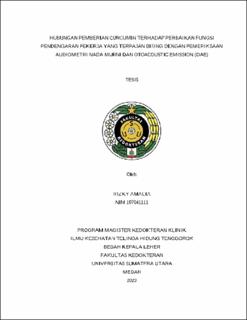| dc.description.abstract | Introduction: Exposure to loud sounds can cause sensorineural hearing loss due to
oxidative stress in the cochlea. Studies have demonstrated that curcumin enhances the
expression of antioxidants and effectively prevents and treats damage to the cochlear
lateral wall fibroblast. Pure tone audiometry can determine the type and extent of hearing
loss and otoacoustic emissions (OAE) can detect early hearing loss.
Objective: To assess the relationship between Curcumin administration and improvement
of hearing function of workers exposed to noise using pure tone audiometry and OAE
examinations.
Method: We conducted this experimental research at Laundry Installation and Nutrition
Installation of Adam Malik Hospital Medan, and the Steel Factory in Medan City. We
examined the workers using pure tone audiometry and OAE, and found that 54 workers
met the inclusion criteria. The samples were divided into 3 groups, namely group 1 as
control group, group 2 received a 500 mg dose of oral curcumin, and group 3 received a
1,000 mg dose of oral curcumin for 4 weeks. Then pure tone audiometry and OAE
examinations were carried out again after treatment.
Results: Based on pure tone audiometry, there was a decrease in hearing threshold in the
control group (p=0.001), in the Curcumin 500 mg group there was an increase in hearing
threshold (p=0.046), in the Curcumin 1,000 mg group there was no change in hearing
threshold (p=0.059). From the OAE examination, in the control group there was a
significant decrease in SNR values at frequencies of 1.5, 2, 3, 6, 7 10, 11, and 12 kHz
between before and after treatment (p<0.001). In the Curcumin 500 mg group, there was
an increase in SNR values at the 4 kHz frequency which was not significant (p=0.013), the
5 kHz frequency which was not significant (p=0.290), the 7 kHz frequency which was not
significant (p=0.009), the 8 kHz frequency which was significant (p<0.001), and the 9 kHz
frequency which was not significant (p=0.031) between before and after treatment. In the
1,000 mg Curcumin group there was an increase in SNR values at the 4 kHz frequency
which was not significant (p=0.121), the 5 kHz frequency which was not significant
(p=0.016), the 7 kHz frequency which was not significant (p=0.330), the 8 kHz frequency
which was not significant (p=0.003), and the 9 kHz frequency was significant (p<0.001)
between before and after treatment.
Conclusion: Curcumin can slow down the process of further hearing damage as shown by
an increase in hearing thresholds from pure tone audiometry examinations and an increase
in SNR values from OAE examinations at several frequencies. | en_US |


